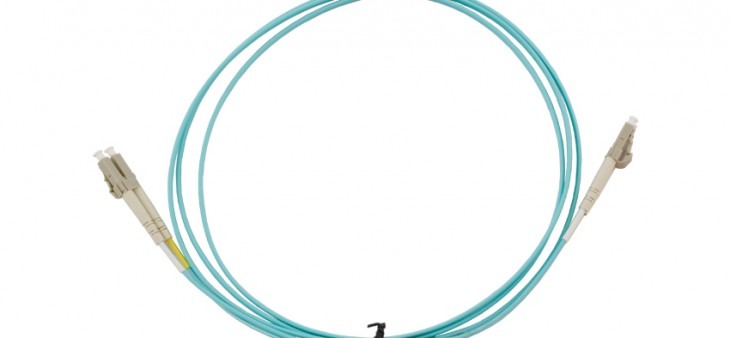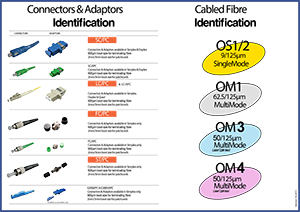
In data communications, multimode fibre transmits digital signals using light. Groups of light rays, called modes, travel through the core of a multi-mode fibre optic cable. The light rays flow simultaneously but are dispersed along differing paths. Multimode fibre is designed for shorter distance transmissions than those on single mode fibre. When multimode fibre optic cable is used over longer lengths, distortion tends to occur on the receiving end, leading to a decrease in signal quality. Multimode operates at 850 and 1300nm wavelengths.
OM1, 2, 3, and 4 Fibre Classifications
Multimode cabling is classified according to an ISO standard as OM1, OM2, OM3 or OM4 cables, with OM as an abbreviation for optical fibre mode. The 1-4 categories are based on modal bandwidth. OM3 is a common choice for 10 Gigabit Ethernet. OM1 is becoming less prevalent.
The following list summarises OM specifications:
OM1 – 100MB Ethernet up to 2000 metres, 1GB up to 275 metres, and 10GB up to 33 metres
OM2 – 100MB up to 2000 metres, 1GB up to 550 metres, and 10GB up to 82 metres
OM3 – 100MB up to 2000 metres, 1GB up to 550 metres, and 10GB up to 300 metres
OM4 – 100MB up to 2000 metres, 1GB up to 1000 metres, and 10GB up to 400 metres
Unsure how to identify fibre connections? Find out more here.
Multimode Fibre Optic Cable
Common types of multimode fibre optic cable are used for data and AV on Local Area Networks. The multi-mode fibre core is larger than a single-mode core. Light moves down the core, which is covered in a material (cladding). The multimode optical fibre cable is designated as 50/125 or 62.5/125 (OM1). This defines the core to cladding diameter as 50 or 62.5 to 125 microns. Multimode fibre optic patch leads and bulk cable are both available.
Understanding Fibre Optic Cable
In all the standards the OM/OS system applies to a cabled optical fibre. The reason for this is obvious, the cabling standards deal with cables and connecting hardware both as products and “as installed”. Even though they call the OM/OS scheme “OF types”, ISO/IEC 11801 and 24702 make it clear that the designation OM1, OM2, OM3, OS1 and OS2 relate to cable transmission performance. For more information single mode fibre.
The BS EN 50173 series makes it even clearer by describing the OM/OS scheme as “optical fibre cable Categories”.
Table 1: Cabled multimode optical fibre specifications

Table 2: Cabled singlemode optical fibre specifications

Both the IEC and EN committees have strengthened this relationship in the production of their cable standards listed below which contain references to OM1, OM2, OM3 and OS1:
Indoor cables
IEC 60794-2-11:2005 (and BS EN 60794-2-11:2005): Detailed specification for simplex and duplex cables for use in premises cabling
IEC 60794-2-21:2006 (and BS EN 60794-2-11:2006): Detailed specification for multi-fibre optical distribution cables for use in premises cabling
IEC 60794-2-31:2006 (and BS EN 60794-2-31:2006): Detailed specification for optical fibre ribbon cables for use in premises cabling
Outdoor cables
IEC 60794-3-12:2006 (and BS EN 60794-3-12:2006): Detailed specification for duct and directly buried optical telecommunication cables for use in premises cabling
IEC 60794-3-21:2006 (and BS EN 60794-3-21:2006): Detailed specification for optical self-supporting aerial telecommunication cables for use in premises cabling


